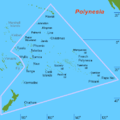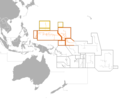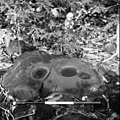
Back بوابة:أوقيانوسيا Arabic ܬܪܥܐ:ܐܘܩܝܢܘܣܝܐ ARC Portal:Polinèsia Catalan دەروازە:ئۆقیانووسیا CKB Portal:Ozeanien German Πύλη:Ωκεανία Greek Portal:Oceanía Spanish Portail:Océanie French Portal:Oseania ID Portale:Oceania Italian
The Oceania PortalOceania (UK: /ˌoʊsiˈɑːniə, ˌoʊʃi-, -ˈeɪn-/ OH-s(h)ee-AH-nee-ə, -AY-, US: /ˌoʊʃiˈæniə, -ˈɑːn-/ OH-shee-A(H)N-ee-ə) is a geographical region including Australasia, Melanesia, Micronesia, and Polynesia. Outside of the English-speaking world, Oceania is generally considered a continent, while Australia is regarded as an island or a continental landmass contained inside of the larger continent of Oceania. Spanning the Eastern and Western Hemispheres, at the centre of the water hemisphere, Oceania is estimated to have a land area of about 9,000,000 square kilometres (3,500,000 sq mi) and a population of around 44.4 million as of 2022. When compared to the continents (which it is often compared to, not including Australia), Oceania is the smallest in land area and the second-least populated after Antarctica. Oceania has a diverse mix of economies from the highly developed and globally competitive financial markets of Australia, French Polynesia, Hawaii, New Caledonia, and New Zealand, which rank high in quality of life and Human Development Index, to the much less developed economies of Kiribati, Papua New Guinea, Tuvalu, Vanuatu, and Western New Guinea, while also including medium-sized economies of Pacific islands such as Fiji, Palau, and Tonga. The largest and most populous country in Oceania is Australia, and the largest city is Sydney. Puncak Jaya in Highland Papua, Indonesia, is the highest peak in Oceania at 4,884 m (16,024 ft). The arrival of European settlers in subsequent centuries resulted in a significant alteration in the social and political landscape of Oceania. The Pacific theatre saw major action during the First World War with the Japanese occupying many German territories. During the Second World War, Allied powers including the United States, the Philippines (a U.S. Commonwealth at the time), and Australia fought against Axis power Japan across various locations in Oceania. (Full article...) Selected geographic article - American Samoa is an unincorporated territory of the United States located in the Polynesia region of the South Pacific Ocean. Centered on , it is southeast of the island country of Samoa, east of the International Date Line and the Wallis and Futuna Islands, west of the Cook Islands, north of Tonga, and some 310 miles (500 km) south of Tokelau. American Samoa is the southernmost territory of the United States, situated 2,200 miles (3,500 km) southwest of the U.S. state of Hawaii, and one of two U.S. territories south of the Equator, along with the uninhabited Jarvis Island. American Samoa consists of the eastern part of the Samoan archipelago—the inhabited volcanic islands of Tutuila, Aunuʻu, Ofu, Olosega and Taʻū and the uninhabited Rose Atoll—as well as Swains Island, a remote coral atoll in the Tokelau volcanic island group. The total land area is 77 square miles (199 km2), slightly larger than Washington, D.C.; including its territorial waters, the total area is 117,500 square miles (304,000 km2), about the size of New Zealand. American Samoa has a tropical climate, with 90 percent of its land covered by rainforests. As of 2024, the population is approximately 47,400 and concentrated on Tutuila, which hosts the capital and largest settlement, Pago Pago. The vast majority of residents are indigenous ethnic Samoans, most of whom are fluent in the official languages, English and Samoan. (Full article...)Related portalsSelected article -The Guadalcanal campaign, also known as the Battle of Guadalcanal and codenamed Operation Watchtower by American forces, was a military campaign fought between 7 August 1942 and 9 February 1943 on and around the island of Guadalcanal in the Pacific theater of World War II. It was the first major land offensive by Allied forces against the Empire of Japan. On 7 August 1942, Allied forces, predominantly United States Marines, landed on Guadalcanal, Tulagi, and Florida Island in the southern Solomon Islands, with the objective of using Guadalcanal and Tulagi as bases in supporting a campaign to eventually capture or neutralize the major Japanese base at Rabaul on New Britain. The Japanese defenders, who had occupied those islands since May 1942, were outnumbered and overwhelmed by the Allies, who captured Tulagi and Florida, as well as the airfield—later named Henderson Field—that was under construction on Guadalcanal. (Full article...)Did you know -
General images -The following are images from various Oceania-related articles on Wikipedia.
TopicsSubcategoriesThings you can doAssociated WikimediaThe following Wikimedia Foundation sister projects provide more on this subject:
In other languagesWikipedia in other languages used in Oceania:
More portals |
© MMXXIII Rich X Search. We shall prevail. All rights reserved. Rich X Search





































































